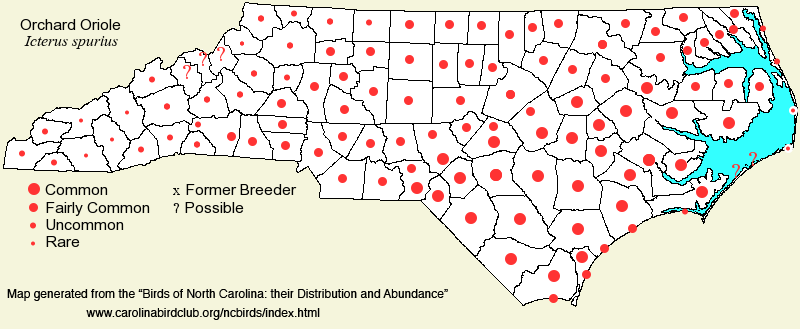 |  |
|
Orchard Oriole - Icterus spurius ICTERIDAE Members: | Search Common: Search Scientific: |
|
|
|||||||
| General Comments | The Orchard Oriole breeding range covers the Eastern Deciduous Forest area of the continent -- nesting mainly in the eastern half of the United States. However, it is not a forest bird, but instead is a bird of groves, open woods and edges, farmland with scattered trees, and other open country with some deciduous trees (for placement of the nest and for foraging). It is one of the earliest-departing species after nesting; most migration takes place in late Jul and Aug, and seldom are birds seen after early or mid-Sep. There are a handful of winter reports, hopefully at least some correct, and all need to be reviewed by the NC BRC, as the species is generally absent from the East by Oct and certainly by Nov; it winters in the tropics. A handful of reports in winter were rejected by CBC editors, or "Briefs for the Files" editors, and never made it to print; details were poor or did not rule out Baltimore Oriole, which does regularly winter in the state. | ||||||
| Breeding Status | Breeder | ||||||
| NC BRC List | Definitive | ||||||
| State Status | |||||||
| U.S. Status | |||||||
| State Rank | S5B | ||||||
| Global Rank | G5 | ||||||
| Coastal Plain | Summer resident, with no obvious migratory movements. Common in summer, over the province as a whole. It is more numerous in the southern half of the province than the north, but is nevertheless reasonably common in the northern counties (provided there is suitable habitat). However, it is uncommon on the Outer Banks, and is likely absent on some coastal islands as a breeder. Mainly early or mid-Apr to late Aug. Pearson et al. (1959) listed these winter reports for the province: Mount Olive (Wayne) from 19, 26, and 30 Dec (no year given) and Greenville on 1 Jan (no year given). Three other known winter reports: an adult male seen in Manteo (Dare) on 29 Dec 1990 [Chat 56:16 link]; an immature male in a Wilmington yard on 17 Feb 2020 and photographed there on 12 Mar 2020 for corroboration; and one in a yard in Morehead City (Carteret), 3-4 Dec 2021 [Chat 86:63 link]. None of these have been reviewed by the NC BRC, and just because at least one was reported as an adult male, there could be confusion with Baltimore Oriole or some other species (such as Hooded Oriole), especially as the first oriole species is known to winter regularly in the Coastal Plain, and as most Orchards have left the state by early Sep. Quite early was an adult male in Morehead City on 20 Mar 1983; and very late was a juvenile photographed at the Lake Mattamuskeet causeway on 22 Nov 2008. Puzzling was a female oriole photographed at Oleander Memorial Gardens (New Hanover) on 21 Nov 2020, reported on an eBird list as an Orchard Oriole; however, it was reported in [Chat 85:36 link] as Icterus sp. owing to its "relatively long, down-curved bill" and was "either an Orchard Oriole or a Hooded Oriole. If this bird was an Orchard Oriole, then it was extremely late, as most depart the region by September." Peak counts: | ||||||
| Piedmont | Summer resident, with no obvious migratory movements. Generally fairly common in summer in the eastern and central portions, and uncommon in the western/foothills portion of the province. Can also be uncommon in some areas with extensive urbanization or extensive forests. Mainly mid-Apr to late Aug or early Sep. Two winter reports: one at Henderson on 11 and 28 Feb (no year given, in Pearson et al., 1959), and a female or immature male seen at Chapel Hill on 10 Feb 1981 [Chat 45:82 link]. Neither were reviewed by an NC BRC, and thus there is concern that these could refer to Baltimore Oriole or some other species. Peak counts: | ||||||
| Mountains | Summer resident, with no obvious migratory movements. Uncommon in lower elevations, mainly in broad valleys, below 3,000 feet. Increasing slowly in the mountains and by 2025 are nesting more often between 3,000 and 3,500 feet. Very rare to almost absent as a breeder above 3,500 feet. Mainly mid-Apr to late Aug. No winter reports. Peak counts: | ||||||
| Finding Tips |
None needed in the Coastal Plain in spring to early summer, by driving back roads, especially through farmlands. *** to **** | ||||||
| Attribution | LeGrand[2025-10-24], LeGrand[2024-11-08], LeGrand[2023-04-02] | ||||||
| NC Map Map depicts all counties with a report (transient or resident) for the species. | Click on county for list of all known species. |
| NC Breeding Season Map Map depicts assumed breeding season abundance for the species. |  |